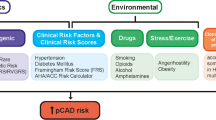Abstract.
High-density lipoproteins (HDLs) play a central role in transporting cholesterol from peripheral tissues to the liver for elimination from the body. Impairment of HDL-mediated cholesterol transport favors cholesterol deposition in the arterial wall and promotes development of arteriosclerosis. Tangier disease is a severe HDL deficiency syndrome characterized by the accumulation of cholesterol in tissue macrophages and prevalent atherosclerosis. A three-decade search for a culprit in Tangier disease led to the identification of mutations in a cell membrane protein called ABCA1, which mediates the secretion of excess cholesterol from cells into the HDL metabolic pathway. Because of its ability to deplete cells of cholesterol and to raise plasma HDL levels, ABCA1 has become a promising therapeutic target for preventing cardiovascular disease.
Similar content being viewed by others
Author information
Authors and Affiliations
Corresponding author
Additional information
Received 17 March 2005; received after revision 11 May 2005; accepted 8 June 2005
Rights and permissions
About this article
Cite this article
Nofer, JR., Remaley, A.T. Tangier disease: still more questions than answers. Cell. Mol. Life Sci. 62, 2150–2160 (2005). https://doi.org/10.1007/s00018-005-5125-0
Published:
Issue Date:
DOI: https://doi.org/10.1007/s00018-005-5125-0




